May 2024
North America News
The U.S. Consumer Product Safety Commission (CPSC) has published a notice of proposed rulemaking to revise and enhance the existing consumer product safety rule for bassinets and cradles.
On 16 April 2024, the CPSC published a notice of proposed rulemaking (16 CFR 1218) to revise the existing safety standard for bassinets and cradles. The proposed rule will adopt ASTM F2194-22e1, with modifications, to ensure identified hazards are addressed and provide the highest possible level of safety.
Examples of products under the scope of the proposed rule include:
Bassinets, cradles and after-market mattresses for bassinets and cradles
Cradle swings with an incline less than or equal to 10° from horizontal while in the rest (non-rocking) position
Multi-use products when they are in the bassinet/cradle use mode
Bassinet/cradle accessories to products when removed from the product and used in the bassinet/cradle mode
Bassinet/cradle features for carriage/stroller when removed from the carriage/stroller and used in the bassinet/cradle mode
The modifications in the standard remove the compact bassinet category and address the following hazards linked to placing young infants in or on:
Non-level bassinets/cradles (suffocation hazard)
Bassinets/cradles on elevated and soft surfaces such as beds, couches, tables and countertops (fall, suffocation, skull fracture, and asphyxia hazards)
Mattresses that are non-flat, too thick, too soft, ill-fitting or unattached to the bassinet/cradle (suffocation hazard)
Bassinets/cradles with design issues, such as low to the ground or unstable, or with loose sidewalls and/or non-mesh sidewalls (containment, tipping, gap entrapment and suffocation hazards)
Products with electrical problems such as smoke, shock and battery leakage (shock and burn hazards)
Interested parties are invited to submit their comments before 17 June 2024.
In the US, when hazards are identified in consumer products, they will be recalled and published in the Consumer Product Safety Commission (CPSC) Recent Recalls on the CPSC website, which is updated daily. The US recalls from 01 April 2024 to 30 April 2024 are summarized below:
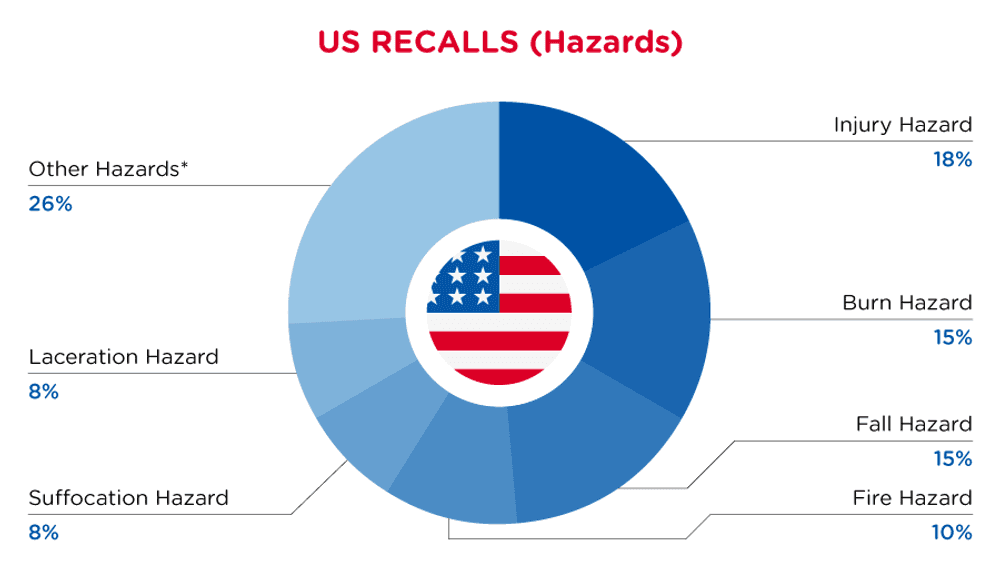
| Hazards | Frequency |
| Injury Hazard | 7 |
| Burn Hazard | 6 |
| Fall Hazard | 6 |
| Fire Hazard | 4 |
| Suffocation Hazard | 3 |
| Laceration Hazard | 3 |
| Other Hazards* | 10 |
*Other Hazards include Risk of Death, Poisoning Hazard, Entrapment Hazard, Damage to Skin, Damage to Hearing, Crash Hazard and Chemical Hazard with a frequency of less than 3.

| Product Categories | Frequency |
| Fabric / Textile / Garment / Home Textile | 5 |
| Sporting Goods / Equipment | 5 |
| Protective Equipment | 3 |
| Toys and Childcare Products | 3 |
| Outdoor Living Items | 2 |
| Furniture | 2 |
| Tools and Hardware | 2 |
| Other Categories* | 5 |
*Other Categories include Chemicals, Home Electrical Appliances, Machinery, Computer / Audio / Video / Other Electronics & Accessories and Food Contact Material with a frequency of less than 2.
For a complete list click here
In Canada, when hazards are identified in consumer products, they will be recalled and published in the Recalls and Safety Alerts Database on the Health Canada website, which is updated daily. The Canada recalls from 01 April 2024 to 30 April 2024 are summarized below:
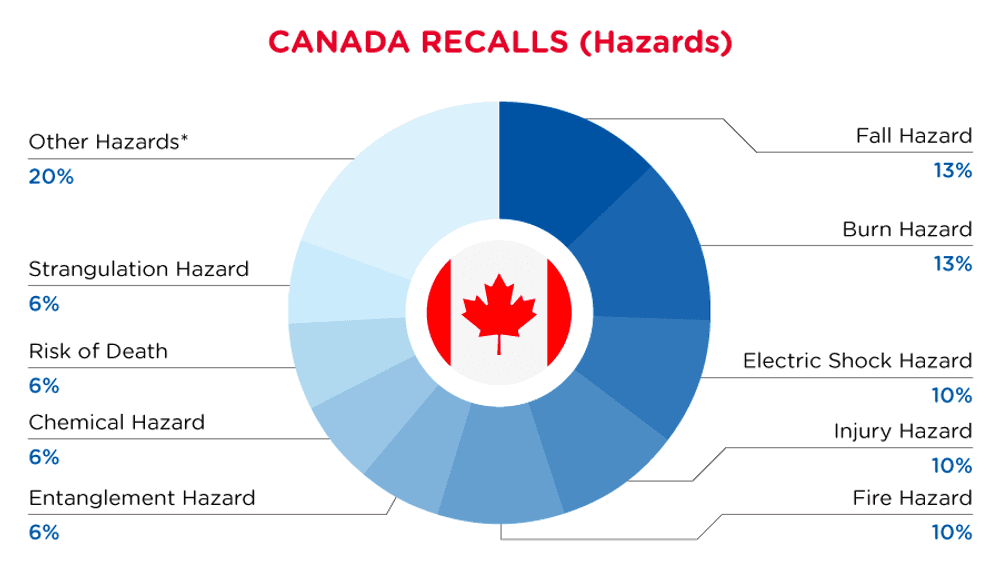
| Hazards | Frequency |
| Fall Hazard | 4 |
| Burn Hazard | 4 |
| Electric Shock Hazard | 3 |
| Injury Hazard | 3 |
| Fire Hazard | 3 |
| Entanglement Hazard | 2 |
| Chemical Hazard | 2 |
| Risk of Death | 2 |
| Strangulation Hazard | 2 |
| Other Hazards* | 6 |
*Other Hazards include Risk of Allergy, Damage to Hearing, Crash Hazard, Suffocation Hazard, Impact Hazard and Entrapment Hazard with a frequency of less than 2.

| Product Categories | Frequency |
| Electrical Appliances | 4 |
| Fabric / Textile / Garment / Home Textile | 3 |
| Sporting Goods / Equipment | 3 |
| Toys and Childcare Products | 3 |
| Tools and Hardware | 2 |
| Protective Equipment | 2 |
| Other Categories* | 5 |
*Other Categories include Household Items, Outdoor Living Items, Machinery, Computer / Audio / Video / Other Electronics & Accessories and Bodycare / Cosmetics with a frequency of less than 2.
For a complete list click here
South America News
Brazil issued Resolution of the Collegiate Board of Directors RDC No. 854 of 04 April 2024 (RDC No. 854/2024) to revise the technical regulation on provisions for packaging, coatings, utensils, lids and metal equipment in contact with food. This resolution was issued on 09 April 2024.
The National Health Surveillance Agency – Anvisa of Brazil has transposed Mercosur/GMC/RES. No. 48/2023 on food contact metals and alloys into its national law. The provisions in the revised technical regulation (RDC No. 854/2024) will become effective on 29 October 2024.
Main changes are summarized below:
1. Deletes copper as one of the heavy metals in impurities of metallic materials.
The new specifications are:
≤ 1% for the sum of antimony, arsenic, cadmium, lead and mercury;
≤ 0.01% for each of cadmium, lead and mercury
≤ 0.03% for arsenic
2. Revises the list of stainless steels and their specifications.
3. Provides specifications and restrictions for anodized and non-anodized aluminium and its alloys.
4. Adds new language indicating that the list of stainless steels in clause 3.1.1 includes those with their surface completely glazed, vitrified, enameled or protected with polymeric coatings.
5. Introduces new language and limitations for uncoated carbon steel.
Manufacturers and distributors of packaging, coatings, utensils, lids and metal equipment in contact with food will need to ensure compliance with the updated regulation.
Europe News
The European Parliament put forth new measures to make packaging more sustainable and reduce packaging waste in the European Union.
In April 2024, the European Parliament addressed packaging concerns by introducing new measures that aim to make packaging used in the European Union (EU) safer and more sustainable. All packaging will be required to be recyclable, focusing on minimizing the presence of harmful substances, reducing unnecessary packaging, boosting the uptake of recycled content and improving collection and recycling. The Council will need to formally approve their provisional agreement before it can enter into force.
Key points and takeaways of the measures outlined are summarized below:
Covers the full life cycle of packaging;
Reduces packaging and restricts certain types,
Includes packaging reduction targets (5% by 2030, 10% by 2035 and 15% by 2040);
Bans certain single use plastic packaging types from 1 January 2030, including a ban on the use of (per- and polyfluorinated alkyl substances or PFASs) above certain thresholds in food contact packaging;
Encourages reuse and refill options for consumers;
Encourages recyclable packaging, better waste collection and varied recycling opportunities.
Notable is that each European generates almost 190kg of packaging waste every year. Parliament is acknowledging concerns to build a more circular economy by introducing these new measures.
In Europe, when hazards are identified in non-food consumer products, the products will be recalled and published in the Safety Gate system, which is updated weekly. The European recalls from 01 April 2024 to 30 April 2024 are summarized below:
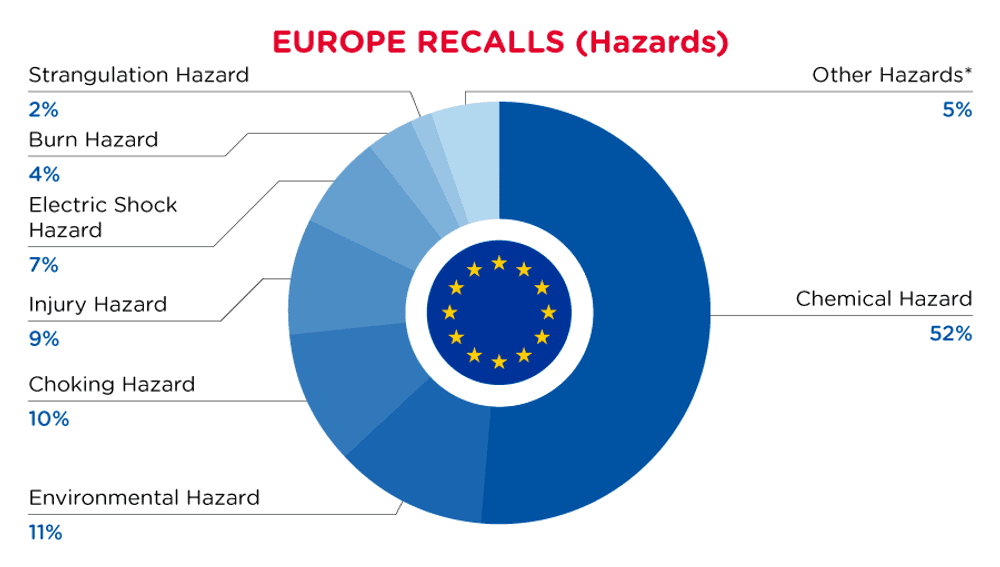
| Hazards | Frequency |
| Chemical Hazard | 144 |
| Environmental Hazard | 32 |
| Choking Hazard | 29 |
| Injury Hazard | 25 |
| Electric Shock Hazard | 20 |
| Burn Hazard | 10 |
| Strangulation Hazard | 5 |
| Other Hazards* | 14 |
*Other Hazards include Health Risk Hazard, Damage to Hearing, Suffocation Hazard, Entrapment Hazard, Fire Hazard, Cut Hazard, Damage to Sight and Microbiological Hazard with a frequency of less than 3.

| Product Categories | Frequency |
| Bodycare / Cosmetics | 75 |
| Toys and Childcare Products | 60 |
| Electrical Appliances | 41 |
| Chemicals | 24 |
| Fabric / Textile / Garment / Home Textile | 11 |
| Jewelry | 10 |
| Protective Equipment | 6 |
| Outdoor Living Items | 5 |
| Other Categories* | 17 |
*Other Categories include Machinery, Home Electrical Appliances, Computer / Audio / Video / Other Electronics & Accessories, Household Items, Sporting Goods / Equipment, Car Accessories, Footwear, Food Contact Material and Stationery with a frequency of less than 4.
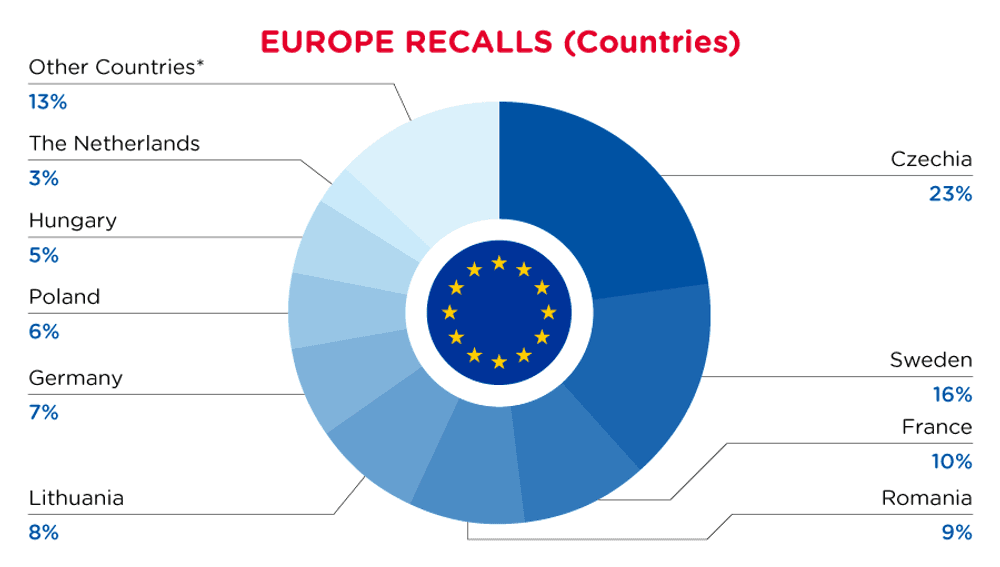
| Notifying Country | Frequency |
| Czechia | 57 |
| Sweden | 39 |
| France | 24 |
| Romania | 22 |
| Lithuania | 21 |
| Germany | 17 |
| Poland | 15 |
| Hungary | 14 |
| The Netherlands | 8 |
| Other Countries* | 32 |
*Other Countries include Ireland, Finland, Denmark, Belgium, Croatia, Norway, Spain, Italy, Cyprus, Estonia and Slovakia with a frequency of less than 8.
For a complete list click here
Asia News
Enterprise Singapore put forth a circular to provide clarification regarding the testing, certification and registration requirements for collapsible electric washing machines and collapsible electric kettles under the Consumer Protection (Safety Requirements) Regulations (CPSR).
Enterprise Singapore issued a circular pertaining to Registration Requirements for Collapsible Products on 16 February 2024.
The purpose of this circular was to provide clarification regarding the testing, certification and registration requirements for collapsible electric washing machines and collapsible electric kettles, as regulated under the Consumer Protection (Safety Requirements) Regulations (CPSR).
As stated in the circular, the collapsible electric washing machines and electric kettles fall within the definitions of existing Controlled Good (CG) categories of washing machines and liquid heating appliances respectively but include the ability to be collapsed to occupy less space for storage or travel purposes.
With effect from 17 February 2025, collapsible electric washing machines and collapsible electric kettles will need to be registered under the CPSR and affixed with the Safety Mark before they can be supplied in Singapore. This mark allows consumers and suppliers to identify products that are Registered Controlled goods. These products shall comply with the same safety standards required for registration of non-collapsible products meaning that:
Collapsible washing machines will need to comply with IEC 60335-2-7, which is the applicable IEC standard for registration of electric washing machines
Collapsible liquid heating appliances will need to comply with IEC 60335-2-15, which is the applicable IEC standard for registration of electric kettles
The Ministry of Health, Labor, and Welfare publishes lists of polymers, additives, and monomers permitted for use in food contact; enforcement of updated list and use requirements is set for 1 June 2025.
In late 2023, the Ministry of Health, Labor, and Welfare (MHLW) published a revision of its positive list of substances for use in food contact materials (FCMs) available in both Japanese and English. This list system was implemented in June of 2020 to allow only those substances evaluated for and determined to be safe to be used in food utensils, containers, and packaging.
The positive list is divided into three documents (two tables): Polymers, additives, and essential monomers each with relevant details including chemical name in Japanese and English, CAS registry numbers, and use requirements.
Enforcement date of the list and use requirements is set for 1 June 2025.
The positive list is similar to the European Union (EU) list. Only substances in the positive lists can be used to manufacture food contact materials and articles.
This updated list also amended the Regulations for Enforcement of the Food Sanitation Act. Under these changes, companies are expected to supply customers with information on usage and safety and keep records of certain data relating to production and the supply.
Compliance must be with both the positive list system (use of determined compliant materials/substances for production) and negative list system (i.e., product compliance based on testing of final product; testing is specific to product type and materials.)
Reference:
China News
In China, when hazards are identified in consumer products, they will be recalled and published in the SAMR Defective Product Administrative Centre, which is updated daily. The China recalls from 01 April 2024 to 30 April 2024are summarized below:
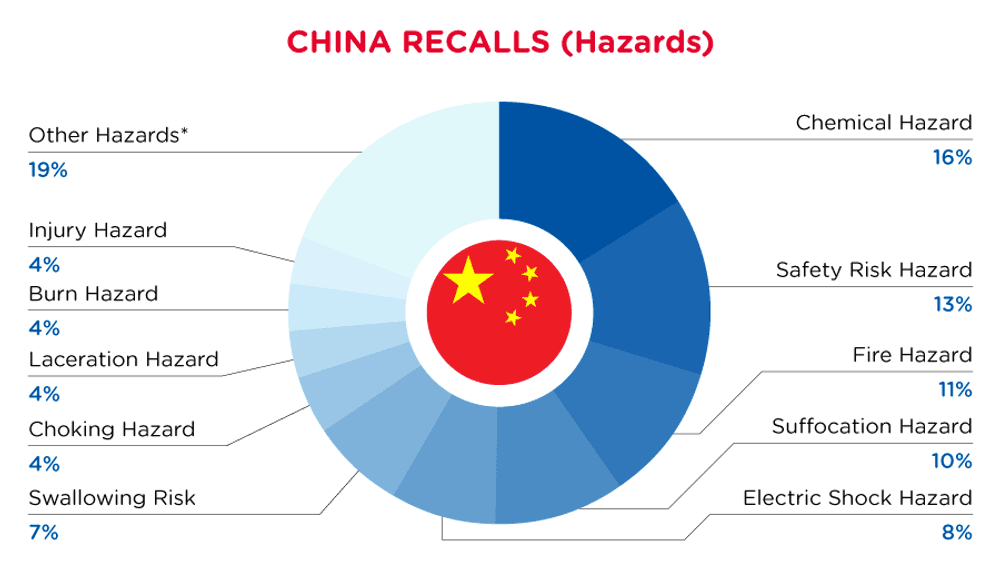
| Hazards | Frequency |
| Chemical Hazard | 18 |
| Safety Risk Hazard | 15 |
| Fire Hazard | 12 |
| Suffocation Hazard | 11 |
| Electric Shock Hazard | 9 |
| Swallowing Risk | 8 |
| Choking Hazard | 5 |
| Laceration Hazard | 4 |
| Burn Hazard | 4 |
| Injury Hazard | 4 |
| Other Hazards* | 21 |
*Other Hazards include Puncture Hazard, Risk of Exposure to Combustion Flue Gas, Fall Hazard, Microbiological Hazard, Explosion Hazard, Crushing Hazard, Damage to Skin, Health Risk Hazard, Skin Irritation Risk, Entanglement Hazard, Crash Hazard, Ingestion Hazard and Tip-Over Hazard with a frequency of less than 4.
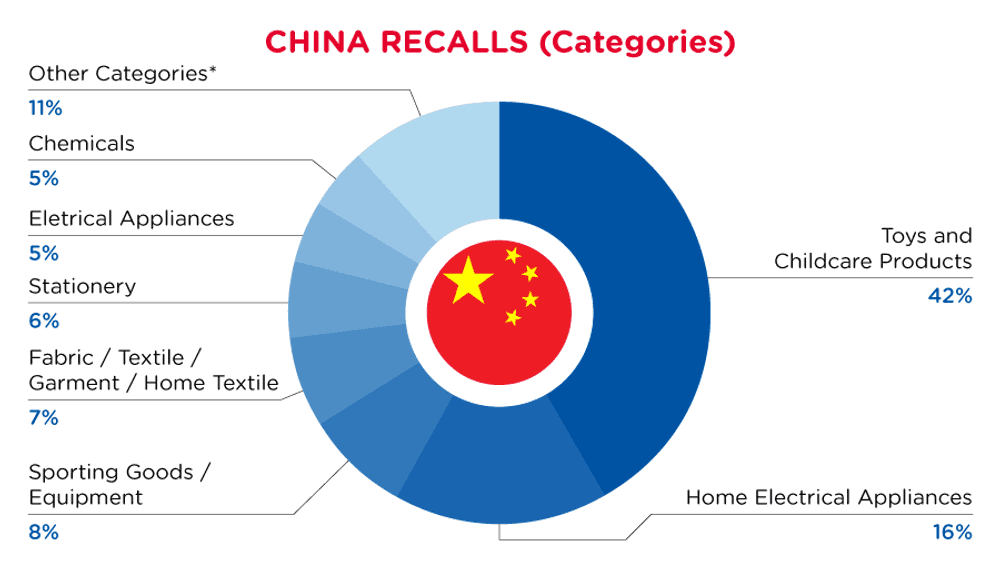
| Product Categories | Frequency |
| Toys and Childcare Products | 36 |
| Home Electrical Appliances | 14 |
| Sporting Goods / Equipment | 7 |
| Fabric / Textile / Garment / Home Textile | 6 |
| Stationery | 5 |
| Electrical Appliances | 4 |
| Chemicals | 4 |
| Other Categories* | 10 |
*Other Categories include Footwear, Food Contact Material, Tools and Hardware, Household Items and Furniture with a frequency of less than 4.
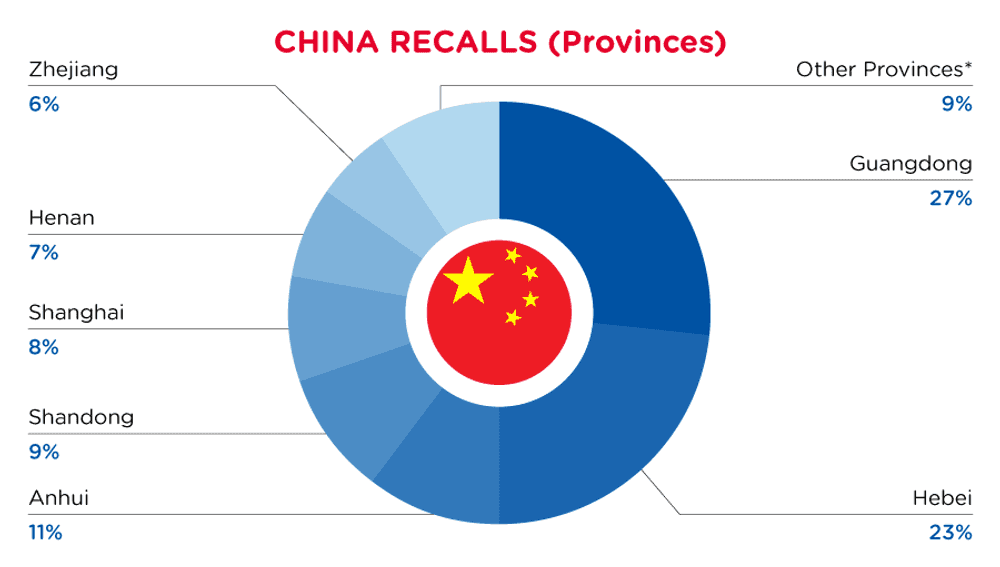
| Provinces | Frequency |
| Guangdong | 23 |
| Hebei | 20 |
| Anhui | 9 |
| Shandong | 8 |
| Shanghai | 7 |
| Henan | 6 |
| Zhejiang | 5 |
| Other Provinces* | 8 |
*Other Provinces include Fujian, Hunan, Inner Mongolia, Beijing and Shanxi with a frequency of less than 5.
For a complete list click here
Australia/New Zealand News
This mandatory standard (https://www.legislation.gov.au/F2024L00362/latest/text) applies to the supply of bicycle helmets in Australia. It sets out the design, construction, performance and safety markings for bicycle helmets.
This mandatory standard was updated on 22 March 2024. There is a transition period until 21 September 2025 for suppliers to adjust to the new mandatory standard.
The Consumer Goods (Bicycle Helmets) Safety Standard in Australia was updated on 22 March 2024, to version F2024L00362. This standard addresses the design, construction, performance and safety markings for bicycle helmets. A helmet for use when riding a bicycle is a regulated bicycle helmet, whether or not it is also for use with one or more other wheeled‑recreational devices.
The mandatory bicycle helmet standard does not apply to these products:
helmets used for downhill mountain bicycle racing
helmets used for BMX bicycle competitive racing
toy helmets
motorcycle helmets
helmets only for use with other wheeled recreational devices which are not bicycles
There is a transition period that ends 21 September 2025 to give suppliers the opportunity to implement the requirements in the new standard.
Requirements during the transitional period are as follows:
(1) During the transitional period, a regulated bicycle helmet must comply with:
(a) the requirements in Part 3; or
(b) the Trade Practices (Consumer Product Safety Standard) (Bicycle Helmets) Regulations 2001, as in force immediately before the commencement of this section.
(2) This section is repealed at the end of the last day of the transitional period.
Requirements after the transitional period:
After the transitional period, a regulated bicycle helmet must comply with the requirements in Part 3.
Part 3—Details of Requirements (as identified in the standard):
Requirements for regulated bicycle helmets.
A regulated bicycle helmet complies with the requirements in this Part if the regulated bicycle helmet complies with each provision of any of the following standards:
(a) Australian/New Zealand Standard AS/NZS 2063:2020, Helmets for use on bicycles and wheeled recreational devices,
(b) Australian/New Zealand Standard AS/NZS 2063:2008, Bicycle helmets
(c) European Standard EN 1078:2012+A1:2012, Helmets for pedal cyclists and for users of skateboards and roller skates
(d)American Society for Testing and Materials Standard ASTM F1447:2018, Standard Specification for Helmets Used in Recreational Bicycling or Roller Skating
(e) U.S. Consumer Product Safety Commission (16 C.F.R. Part 1203), Safety Standard for Bicycle Helmets
(f) Snell B‑95, 1995 Bicycle Helmet Standard, 1998 revision Standard for Protective Headgear for Use in Bicycling
In Australia, when hazards are identified in consumer products, they will be recalled and published in the Recalls and Safety Alerts Database on the Australian Competition & Consumer Commission website, which is updated daily. The Australia recalls from 01 April 2024 to 30 April 2024are summarized below:
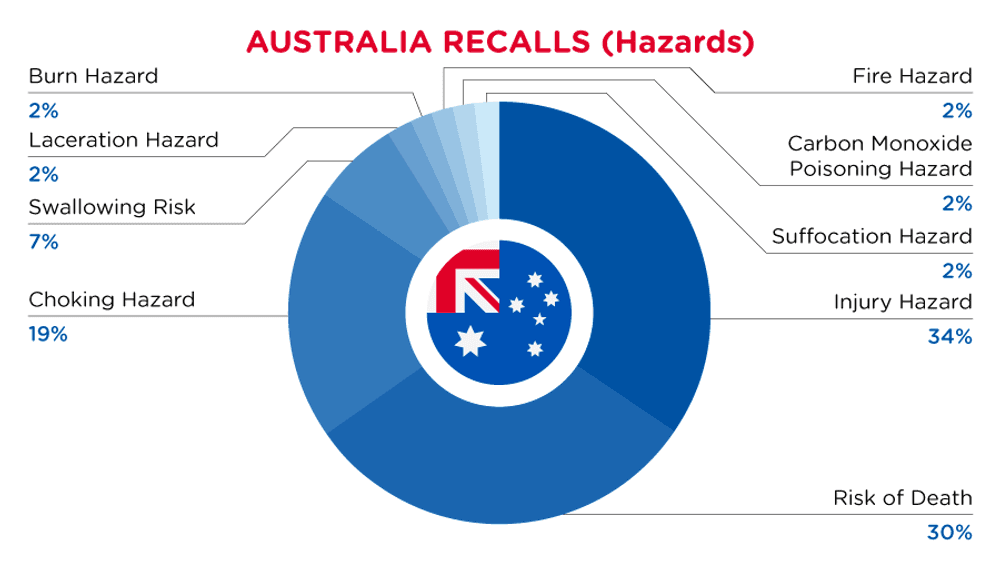
| Hazards | Frequency |
| Injury Hazard | 20 |
| Risk of Death | 18 |
| Choking Hazard | 11 |
| Swallowing Risk | 4 |
| Laceration Hazard | 1 |
| Burn Hazard | 1 |
| Fire Hazard | 1 |
| Carbon Monoxide Poisoning Hazard | 1 |
| Suffocation Hazard | 1 |
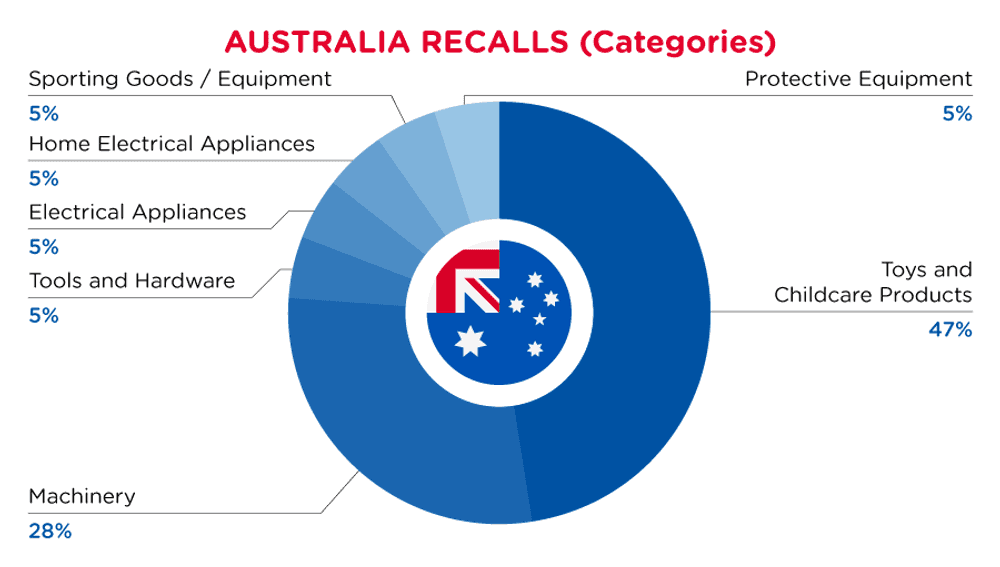
| Product Categories | Frequency |
| Toys and Childcare Products | 10 |
| Machinery | 6 |
| Tools and Hardware | 1 |
| Electrical Appliances | 1 |
| Home Electrical Appliances | 1 |
| Sporting Goods / Equipment | 1 |
| Protective Equipment | 1 |
For a complete list click here
Subscribe to our Regulatory Updates
Unsubscribe at any time. Read our privacy policy.